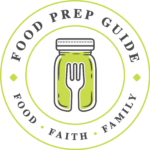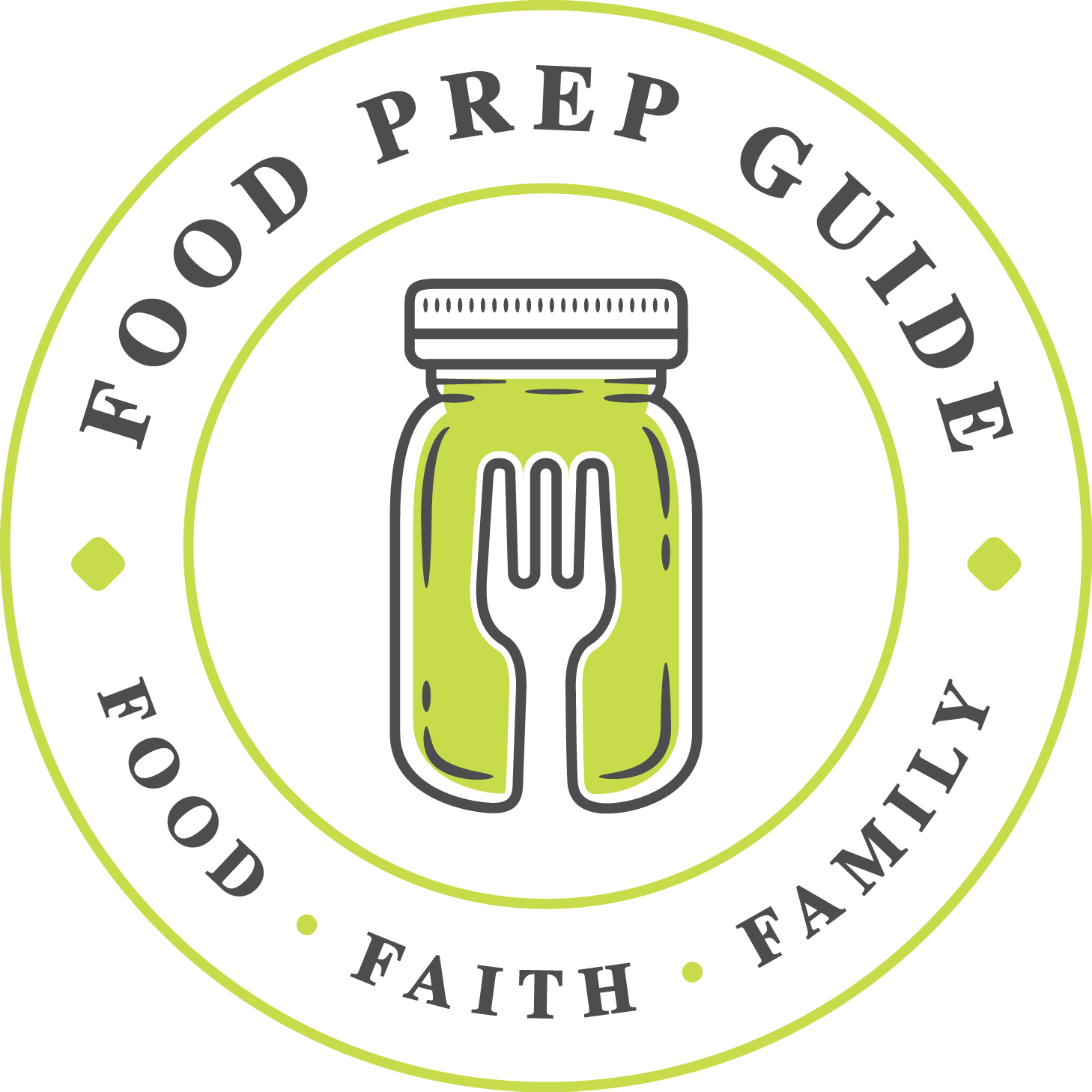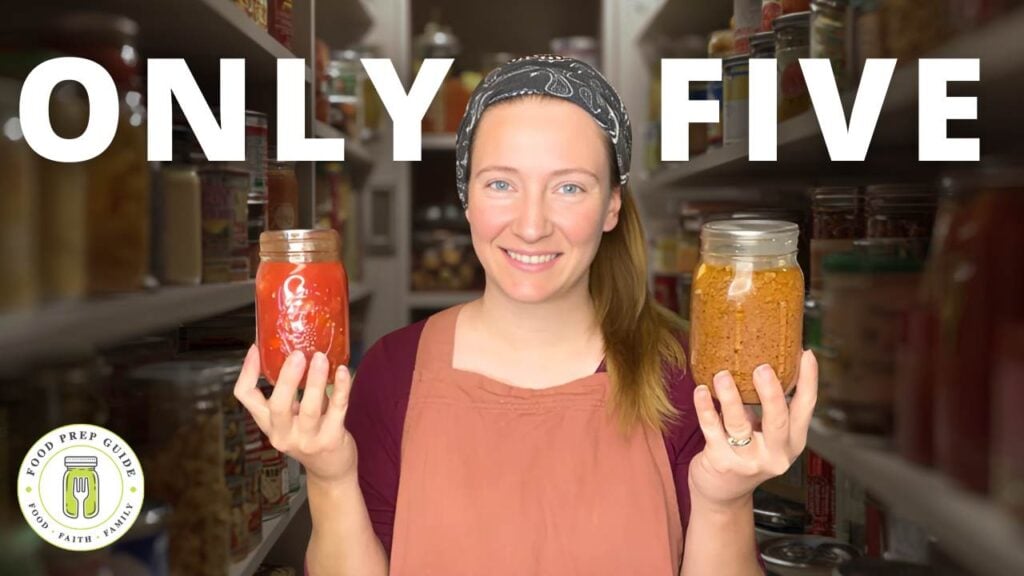If you could only store five canned foods in your pantry, what would they be?
I know, I know—you’re probably expecting me to tell you the usual generic advice like “stock canned meats, vegetables, and fruits.” But that’s vague, unhelpful, and honestly just common sense.
Today I’m getting specific. I’m sharing exactly which five canned foods to prioritize, how to use each one to get maximum value and versatility, and three popular items that might be wasting your storage space.
Whether you’re working with limited space, a tight budget, or just want to cut through the overwhelm of food storage, this is for you.
1. Canned Tomatoes: The Foundation of Every Pantry
This might seem obvious, but it’s easy to underestimate just how powerful this one ingredient can be.
Canned tomatoes can transform almost any basic ingredient combination into something that doesn’t taste like a struggle meal. Sure, they provide vitamin C and lycopene, but the real reason they’re on this list is their ability to make boring ingredients taste good.
Here’s the versatility: Blend canned tomatoes into a smooth puree for pasta sauce in minutes. Add garlic powder, dried herbs, maybe a pinch of sugar to balance the acidity. Or cook those same tomatoes down for 30-45 minutes on lower heat until they become thick and concentrated—now you have pizza sauce with deep, rich flavor.
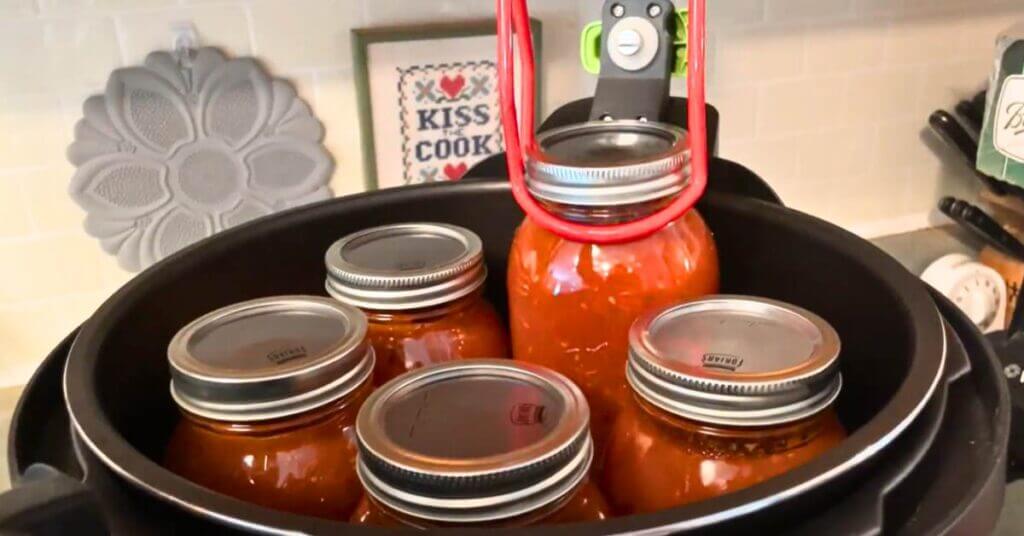
Three stages, three uses, same can of tomatoes. It’s such a workhorse.
Canned tomatoes work as a soup base—just add broth or water and whatever vegetables and protein you have for quick minestrone. They’re great for rice dishes like Spanish rice. Throw in some coconut milk and curry powder for a quick curry. The possibilities are endless.
Want help building a complete food storage plan? Comment “food storage” below and I’ll send you our FREE one-year food storage plan that breaks down a year’s worth of shelf-stable food into week-by-week purchases that won’t break the bank.
2. Canned Tuna or Salmon: Nutrients You Can’t Get Anywhere Else
This choice is all about getting nutrients that are genuinely hard to come by in shelf-stable foods.
You might raise chickens for eggs and meat. You might hunt. But getting a healthy dose of omega-3 fatty acids? That’s where canned fish becomes irreplaceable.
Why omega-3s matter: Your body can’t make them, so you have to get them from food or supplements. They’re crucial for brain function and reducing inflammation. Most shelf-stable foods don’t contain this nutrient at all. Nuts and seeds have some (especially chia seeds), but it’s not the same type your body needs most.
Canned fish gives you that nutrition in a form that stores well for years.
Beyond tuna salad: Make tuna melts, add it to scrambled eggs for extra protein, make tuna patties, or serve on toast with gravy. Canned salmon works wonderfully in fried rice—just add it in the last minute so it doesn’t fall apart. Mix salmon with breadcrumbs or oats, an egg, and seasonings, then pan-fry for quick salmon patties.
Fresh fish is great when you can get it, but canned fish has its own strengths: shelf-stable, affordable, portion-controlled, and consistently available.
3. Canned Corn: The Underestimated Powerhouse
This is where people either get it or they don’t.
Some folks see corn as just a side dish. I see it as filling, affordable calories that can be transformed in so many ways.
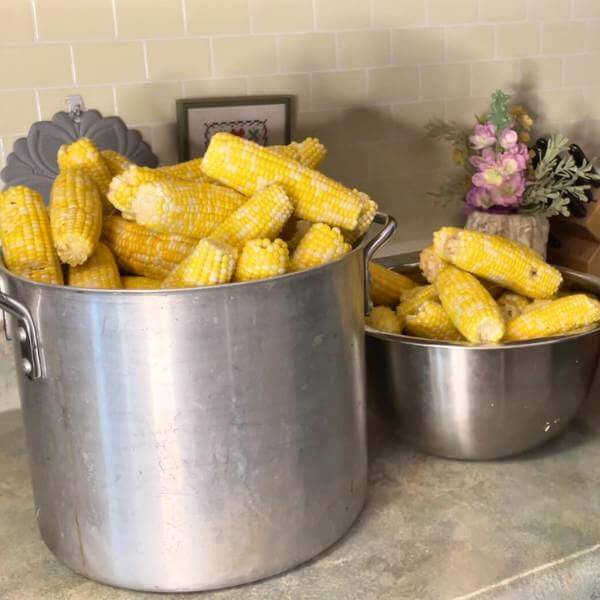
The basics: Corn provides carbohydrates for energy. Unlike some vegetables, it’s substantial enough to fill you up. Mix it with protein—eggs, tuna, chicken—and you have a complete meal. It’s naturally sweet without a bunch of added sugar, which is valuable when you’re working with limited ingredients and everything starts tasting bland.
But here’s where corn really shines: Drain canned corn and dehydrate it. Once completely dried, grind it in a coffee grinder or food processor to make cornmeal. Now you can make cornbread, adding serious variety to your meals.
Corn works as a soup ingredient, particularly good for adding bulk and sweetness. Corn chowder is basically just corn, dairy or non-dairy milk, seasonings, and whatever vegetables you like, all blended together.
The simplest uses? Mix into rice dishes, add to salads for crunch, or serve straight from the can as a quick side.
4. Canned Soups: Zero Mental Energy Required
This isn’t about convenience over nutrition or being lazy about cooking. It’s about having a complete meal on your shelf that requires zero mental energy when life is overwhelming.
Maybe you’re sick, exhausted, dealing with stress, or facing emergency situations where planning and preparing a meal feels like too much. Maybe you’re recovering from surgery. Maybe you’re dealing with a family crisis. Maybe you’re just having one of those days where everything feels hard.
FREE FOOD STORAGE PLAN!
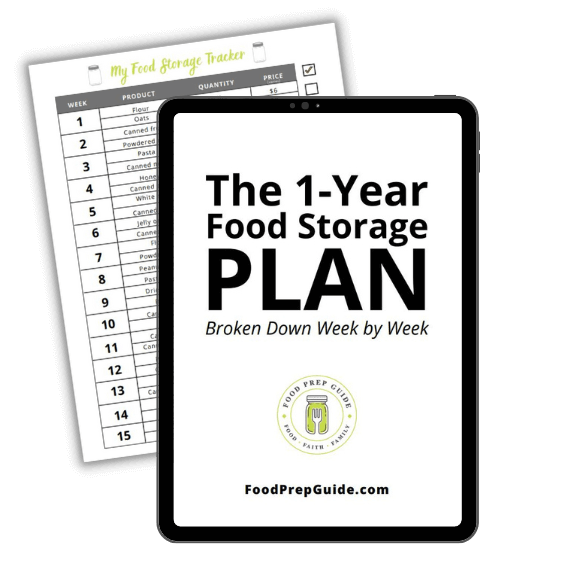
Does gathering and storing a year’s worth of food for your family seem overwhelming and unachievable?
Make it easy with our step-by-step plan. Subscribe to our weekly newsletter & we’ll send it to you FREE!
In those moments, you need food that removes all decision-making from the equation. Canned soup is grab-and-go nutrition. Heat it if you can, eat it cold if you have to. No chopping, no combining ingredients, no thinking about what goes with what.
Not all canned soups are created equal. You want hearty varieties with substance—particularly ones with protein (chicken, beef, or beans) plus vegetables. Avoid thin, brothy ones that are mostly water and salt. Go for chunky soups, stews, and chilies that are more like complete meals.
Bonus use: Canned soups can serve as cooking bases. Tomato soup becomes pasta sauce with added herbs. Chicken soup stretches with rice and noodles. Vegetable soups become cooking liquid for grains like quinoa or rice.
When you’re eating from food storage for an extended period, things start tasting the same. Having different soup flavors means you can switch up the taste without extra effort.
5. Canned Peaches: More Than Just Fruit
I could tell you to stock canned fruit in general, but I wanted to be specific. I chose peaches because they offer something unique: vitamin C content.
A lot of shelf-stable foods don’t contain much vitamin C, and it’s a nutrient your body can’t store—you need it regularly. Canned peaches provide a decent amount in a form that stores well. This is particularly important if you’re relying on stored foods for an extended period or fresh produce isn’t readily available.
But the real benefit happens when you start thinking beyond eating them straight from the can. Blend canned peaches for a natural fruit spread that works on toast, biscuits, or flavors oatmeal. Use as filling for thumbprint cookies or layer in simple cakes. The natural sugars mean you need less added sugar in recipes.
Prices pulled from the Amazon Product Advertising API on:
Product prices and availability are accurate as of the date/time indicated and are subject to change. Any price and availability information displayed on [relevant Amazon Site(s), as applicable] at the time of purchase will apply to the purchase of this product.
If you’re working with just flour, sugar, salt, and yeast—the bare minimum baking supplies—canned peaches can turn plain muffins into peach muffins, quick breads into peach bread, or simple oatmeal cookies into peach-flavored ones.
Even the syrup is useful: Use as simple syrup for beverages, sweetener for plain yogurt (yes, you can make yogurt from powdered milk for food storage!), or a moistening agent for dry cakes and muffins.
From a psychological standpoint, having something sweet and fruity matters more than it seems. Access to natural sweetness and bright flavors can genuinely improve your mood and make whatever experience you’re in more bearable.
3 Things NOT Worth Your Canned Goods Space
Canned goods already take up a lot of space, so here are three things I generally don’t store canned:
1. Canned Beans – Store dried beans instead. They last incredibly long and cost a fraction of the price. Yes, they take time to cook, but it’s not difficult—soak overnight, boil for an hour with fresh water, and you’re done.
You’ll get way more beans for your money. (I do can beans from dried to have them ready for quick meals, but I make them from dried beans, not buy them from the store.)
2. Canned Broth – This is so easy to make yourself. Save vegetable scraps, use bones left over from meats, add water and seasonings.
Check out our favorite onion broth recipe!
You’re paying premium prices for flavored water at the store when you can make it at home for pennies on the dollar.
3. Root Vegetables – Things like potatoes, carrots, sweet potatoes, and onions store really well on their own for months when kept properly. No need to waste can space on these.
Smart Food Storage Made Simple
There you have it—five canned foods that give you peace of mind without breaking the bank or taking up too much space. Each one serves multiple purposes and can transform basic ingredients into real meals.
Remember, smart food storage isn’t about having the most cans. It’s about having the right cans that work harder for you.
